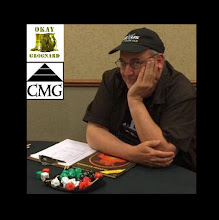In the Fall of 2007, Ben Robbins began blogging about his sandbox game, the
West Marches, on his WordPress site
ars ludi. The five parts series of blogs began in October of that year as
Grand Experiments: West Marches, was followed by two more in that same month in the form of
Sharing Info and
Recycling, then a fourth in December of 2007 titled
Death & Danger (a sly nod to D&D), and finally was revisted in May of 2008 with a
Running Your Own. The series is an excellent discourse on sandbox-style tabletop roleplaying game setting design and Game Mastering.
In Part One, Robbins first sets out his motivations and goals. Although someone could use his experiment as a template for a weekly game with the same recurring group of players and characters, this was not his situation. Robbins had plenty of players, as it turns out something on the order of fifteen who played from time to time, but getting any number of them together to play on any given day of the week was problematic, so he designed his campaign to allow for the players to call the game night and provide enough players from the pool to make it worthwhile for everyone. For this effort, sandbox-style gaming was ideally suited. The players would make discoveries in the course of playing that would motivate them to organize parties of characters for each foray. Robbins likens this, appropriately, to the characters gathering at the local watering hole and mustering the numbers necessary to accomplish their planned excursions. This form-following-function method was motivating his own creative powers and worked well for Robbins, too. As the players planned, he ensured they also knew he would need to be given some time to prepare for the sessions. The knock-on effect was that the players then had a plan in advance of the game and some extra time to refine their approach with the roster of available player characters they managed to engage.
The setting design was radial, spreading out from "fortified town that marked the farthest outpost of civilization and law." Areas closest to civilization were primarily less dangerous than those farther away, with some exceptions I'll mention later. This is notably similar to some early advice in (O)D&D from Gygax when discussing underworld design (The Underworld & Wilderness Adventures: Volume 3 of (O)D&D, page 9) in regard to successive levels of dungeons needing to be "progressively more dangerous and difficult." He makes no such mention regarding Outdoor setting design in those early booklets, as player character exploration in the wild was considerably more dangerous. Gyagx does, however, discuss such reasoned design in the his next edition when writing "The same concept applies to areas outdoors as well, with more and terrible monsters occurring more frquently the further one goes away from civilization" (AD&D 1E DMG, page 87). One would find Dante's tour of the Inferno, if he were an adventurer battling his way through, rather anticlimactic if when venturing into the First Circle he and Virgil were beset by the sword-wielding demon from the Eighth Circle and subsequently slaughtered. Abandon all hope, indeed.
Robbins places few restrictions on the players and their characters beyond disallowing action away from the frontier and discouraging in-town exploration. If I have one quibble, it is with the latter stipulation. I understand his motivation for nudging the player characters out of the nest, and keeping the nest as a perpetual safe haven given that his on again, off again group of players needed that zone to exist for organizational purposes. However, I am a big fan of having that third leg of adventuring locations: Underworld, Wilderness, and Urban. It is often a good places to get initial clues and ongoing information but for Robbins's purposes that sort of thing is either hand-waved or freely given in a narrative form. Clearly, that worked great for what he wished to accomplish.
Bottom line? Ben Robbins's West Marches blogs are an excellent treatise, on creating a campaign setting and on game design, that prospective GMs would do well to read and heed. This is particularly true for sandbox games but understanding the concepts would assist non-sandbox GMs as they strive for consistency between game sessions so that players feel the setting they explore engenders meaningful choices even in more linear styles of play. I'll blog more on his subsequent blog posts, and on the whole, and include more thoughts of my own, some additions and alternatives, in due course. In the meantime, read his series. It's outstanding!

